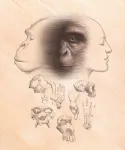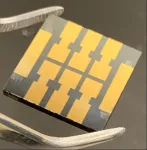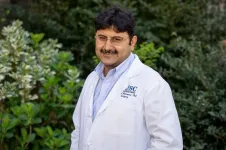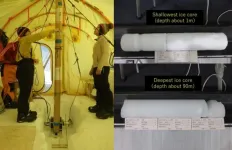Rooted tree key to understanding bacterial evolution, new study suggests
2021-05-06
(Press-News.org) The findings, published in the journal Science today, demonstrate how integrating vertical descent and horizontal gene transfer can be used to infer the root of the bacterial tree and the nature of the last bacterial common ancestor.
Bacteria comprise a very diverse domain of single-celled organisms that can be found almost everywhere on Earth. All Bacteria are related and derive from a common ancestral Bacterial cell. Until now, the shape of the bacterial tree of life and the placement of its root has been contested, but is necessary to shed light on the early evolution of life on our planet.
Just as in plants and animals, the genomes of Bacteria are home to many different genes. However, Bacterial genes are not only inherited vertically from mother to daughter, but are also frequently exchanged horizontally between potentially distant family members. Amongst its many functions, horizontal gene sharing drives the rapid spread of antibiotic resistance amongst pathogenic Bacteria.
The combination of vertical and horizontal ancestry complicates how we think about evolutionary relationships among Bacteria, with the former best represented as a tree and the latter as a network. The team used phylogenetic methods that simultaneously consider the vertical and horizontal transmission of genes and found that, on average, genes travel vertically two-thirds of the time, suggesting that a tree provides a meaningful framework for interpreting bacterial evolution.
Co-author Phil Hugenholtz, at the University of Queensland, Australia, noted: "For years, vertical and horizontal evolution have been seen as adversaries with researchers often falling into the tree or network camp. Here we show that they can be investigated together to address some of the most vexing questions in early evolution."
"Overlaying the horizontal movement of genes onto the vertical "species" tree allowed us to identify the most likely root of the tree and the gene content of the last bacterial common ancestor (LBCA)." explains co-author Gergely Szöll?si, at Eötvös Loránd University, Hungary.
The analysis predicts a root between two major clades, the Terrabacteria (mostly Bacteria with single-membranes such as Bacillus) and the Gracilicutes (mostly Bacteria with a double-membrane such as E. coli). This contrasts with recent proposals placing the Candidate Phyla Radiation (CPR) at the base of the tree. CPR are unusual ultrasmall Bacteria reliant on other host cells for survival.
"Our analyses suggested that the CPR are members of the Terrabacteria and sister to the free-living Chloroflexota meaning that the host dependency of CPR Bacteria is a derived rather than ancestral characteristic" said co-author Anja Spang, at The Royal Netherlands Institute for Sea Research (NIOZ) in the Netherlands.
The authors predict that LBCA was more complex than previously thought, having a double-membraned cell that was able to swim, sense its environment, and defend itself against viruses.
Dr Williams explained: "Bacteria can have one or two cell membranes, and one of the big questions in early evolution is how these two kinds of cells are related to each other. Our analysis suggests that the common ancestor of all living Bacteria already had two membranes, so the question now is how apparently simpler single-membrane cells evolved from double-membraned cells, and how many times this has occurred during evolution. We believe that our approach to integrating vertical and horizontal gene transmission holds promise for answering this and many other open questions in evolutionary biology."
INFORMATION:
Paper: Coleman GA, Davín AA, Mahendrarajah T, Spang A, Hugenholtz P, Szöll?si GJ, Williams TA. 2021. A rooted phylogeny resolves early bacterial evolution. Science
[Attachments] See images for this press release:

ELSE PRESS RELEASES FROM THIS DATE:
2021-05-06
The uncertainty principle, first introduced by Werner Heisenberg in the late 1920's, is a fundamental concept of quantum mechanics. In the quantum world, particles like the electrons that power all electrical product can also behave like waves. As a result, particles cannot have a well-defined position and momentum simultaneously. For instance, measuring the momentum of a particle leads to a disturbance of position, and therefore the position cannot be precisely defined.
In recent research, published in Science, a team led by Prof. Mika Sillanpää at Aalto University in Finland has shown that there is a way to get around ...
2021-05-06
In the 150 years since Charles Darwin speculated that humans originated in Africa, the number of species in the human family tree has exploded, but so has the level of dispute concerning early human evolution. Fossil apes are often at the center of the debate, with some scientists dismissing their importance to the origins of the human lineage (the "hominins"), and others conferring them starring evolutionary roles. A new review out on May 7 in the journal Science looks at the major discoveries in hominin origins since Darwin's works and argues that fossil apes can inform us about essential aspects of ape and human evolution, including the nature ...
2021-05-06
PROVIDENCE, R.I. [Brown University] -- A research team from Brown University has made a major step toward improving the long-term reliability of perovskite solar cells, an emerging clean energy technology. In a study to be published on Friday, May 7 in the journal Science, the team demonstrates a "molecular glue" that keeps a key interface inside cells from degrading. The treatment dramatically increases cells' stability and reliability over time, while also improving the efficiency with which they convert sunlight into electricity.
"There have been great strides ...
2021-05-06
MUSC Hollings Cancer Center researchers added to the understanding of the protective immune response against the SARS-CoV-2 virus in a study published in April in iScience. The team found that approximately 3% of the population is asymptomatic, which means that their bodies can get rid of the virus without developing signs of illness.
The researchers screened more than 60,000 blood samples from symptomless individuals in the Southeastern U.S., including Georgia, South Carolina and North Carolina, for the IgG antibody to the viral spike protein.
What began as a highly collaborative statewide effort to detect SARS-CoV-2 accurately, ...
2021-05-06
Recently published research from the University of Arizona Health Sciences shows that advanced-stage kidney cancer is more common in Hispanic Americans and Native Americans than in non-Hispanic whites, and that both Hispanic Americans and Native Americans in Arizona have an increased risk of mortality from the disease.
"We knew from our past research that Hispanic Americans and Native Americans have a heavier burden of kidney cancer than non-Hispanic whites," said Ken Batai, PhD, a Cancer Prevention and Control Program research member at the UArizona Cancer Center and research assistant professor of urology in the College of Medicine - Tucson. "But we also know that around 90% of the Hispanic population in Arizona is Mexican American - either U.S.-born or Mexican-born ...
2021-05-06
The air in the United States and Western Europe is much cleaner than even a decade ago. Low-sulfur gasoline standards and regulations on power plants have successfully cut sulfate concentrations in the air, reducing the fine particulate matter that harms human health and cleaning up the environmental hazard of acid rain.
Despite these successes, sulfate levels in the atmosphere have declined more slowly than sulfur dioxide emissions, especially in wintertime. This unexpected phenomenon suggests sulfur dioxide emission reductions are less efficient than expected for cutting sulfate aerosols. A new study led by Tokyo Institute of Technology (Tokyo Tech), Hokkaido University and the University ...
2021-05-06
The ability of antibodies to recognize specific cancer cells is used in oncology to specifically target those cells with small active agents. Research published in the journal Angewandte Chemie shows that scientists have now built a transport system that delivers even large protein-based drugs into cancer cells. This study demonstrates how proteins can arrive at their target intact, protected from destructive proteases by polymer brushes.
Developing anticancer treatments involves two recurring problems for researchers. An active agent needs to be able to kill the body's cells at the root of the cancer, and it should be active in target cancer cells rather than in healthy cells. Many medical researchers ...
2021-05-06
When you save an image to your smartphone, those data are written onto tiny transistors that are electrically switched on or off in a pattern of "bits" to represent and encode that image. Most transistors today are made from silicon, an element that scientists have managed to switch at ever-smaller scales, enabling billions of bits, and therefore large libraries of images and other files, to be packed onto a single memory chip.
But growing demand for data, and the means to store them, is driving scientists to search beyond silicon for materials that can push memory devices to higher densities, ...
2021-05-06
For millennia, humans in the high latitudes have been enthralled by auroras--the northern and southern lights. Yet even after all that time, it appears the ethereal, dancing ribbons of light above Earth still hold some secrets.
In a new study, physicists led by the University of Iowa report a new feature to Earth's atmospheric light show. Examining video taken nearly two decades ago, the researchers describe multiple instances where a section of the diffuse aurora--the faint, background-like glow accompanying the more vivid light commonly associated with auroras--goes dark, as if scrubbed by a giant blotter. Then, after a short period of time, the blacked-out section suddenly reappears.
The researchers say the behavior, which they call "diffuse ...
2021-05-06
New research published in Experimental Physiology highlight the possible long term health impacts of COVID-19 on young, relatively healthy adults who were not hospitalized and who only had minor symptoms due to the virus.
Increased stiffness of arteries in particular was found in young adults, which may impact heart health, and can also be important for other populations who may have had severe cases of the virus. This means that young, healthy adults with mild COVID-19 symptoms may increase their risk of cardiovascular complications which may continue for some time after COVID-19 infection.
While SARS-CoV-2, the virus known ...
LAST 30 PRESS RELEASES:
[Press-News.org] Rooted tree key to understanding bacterial evolution, new study suggests





